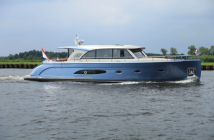The mere prospect of a rogue wave is enough to strike fear in the heart of most cruising skippers. Rogue, or freak, waves appear without warning, and they are strong enough to sink large ships. But what causes a rogue wave, and how bad can they really be?
Now researchers at the Universities of Oxford and Edinburgh have determined what causes rogue waves. The answer: Smaller groups of waves that cross at an angle of 120 degrees.
To work out the conditions that cause a rogue wave, which is at least twice as high as surrounding waves, the researchers tried to recreate the famous Draupner wave. Known as the first rogue wave to be accurately measured, that wave hit the Draupner oil platform in the North Sea, about 100 miles from the southern tip of Norway, on Jan. 1, 1995.
The platform was built with accurate sensors to measure wave heights and strengths. They recorded a rogue wave that was 85 feet high that hit the platform at 45 miles an hour; it also was more than twice as tall and steep as its neighboring waves.
Until that time, scientists thought that a wave that high would occur only once every ten thousand years.
Researchers tried to reproduce the Daupner wave at the FloWave Ocean Energy Research lab at the University of Edinburgh. They were able to do so when the waves crossed at the 120 degree angle. “When waves are not crossing, wave breaking limits the height that a wave can achieve,” they wrote. “However, when waves cross at large angles, wave-breaking behavior changes and no longer limits the height a wave can achieve in the same manner.”
In a case of life imitating art, the waves the researchers created looked very similar to The Great Wave of Kanagawa, a woodblock print published in the early 1800s by the Japanese artist Katsushika Hokusai (shown above).
Although there have been many stories about the height of rogue waves, there also have been a few waves that have been accurately measured. In 2004, the U.S. Naval Research Lab, with underwater sensors, detected a freak wave in the Gulf of Mexico caused by Hurricane Ivan that was 91 feet from peak to trough, and 660 feet long. And in 2000, a British scientific vessel recorded a wave 95 feet high off the coast of Scotland. Read more:




